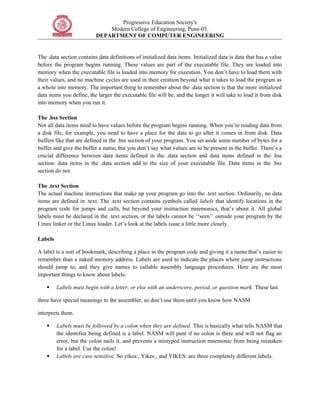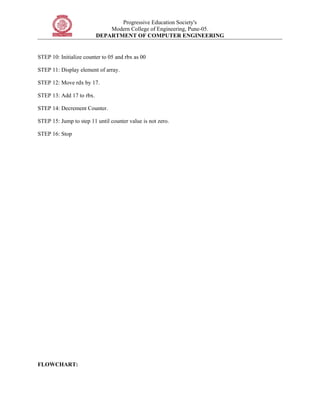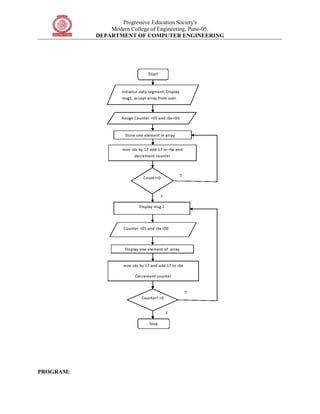64-bit Assembly language program to Accept and display numbers.docx
- 1. Progressive Education Society's Modern College of Engineering, Pune-05. DEPARTMENT OF COMPUTER ENGINEERING Lab Assignment No: 01 AIM: Write an X86/64 ALP to accept five 64 bit Hexadecimal numbers from user and store them in an array and display the accepted numbers. OBJECTIVES: To understand assembly language programming instruction set To understand different assembler directives with example To apply instruction set for implementing X86/64 bit assembly language programs ENVIRONMENT: Operating System: 64-bit Open source Linux or its derivative. Programming Tools: Preferably using Linux equivalent or MASM/TASM/NASM/FASM. Text Editor: geditor THEORY: Introduction to Assembly Language Programming: Each personal computer has a microprocessor that manages the computer's arithmetical, logical and control activities. Each family of processors has its own set of instructions for handling various operations like getting input from keyboard, displaying information on screen and performing various other jobs. These set of instructions are called 'machine language instruction'. Processor understands only machine language instructions which are strings of 1s and 0s. However machine language is too obscure and complex for using in software development. So the low level assembly language is designed for a specific family of processors that represents various instructions in symbolic code and a more understandable form. Assembly language is a low-level programming language for a computer, or other programmable device specific to particular computer architecture in contrast to most high-level programming languages, which are generally portable across multiple systems. Assembly language is converted into executable machine code by a utility program referred to as an assembler like NASM, MASM etc. Advantages of Assembly Language An understanding of assembly language provides knowledge of: Interface of programs with OS, processor and BIOS; Representation of data in memory and other external devices; How processor accesses and executes instruction; How instructions accesses and process data; How a program access external devices.
- 2. Progressive Education Society's Modern College of Engineering, Pune-05. DEPARTMENT OF COMPUTER ENGINEERING Other advantages of using assembly language are: It requires less memory and execution time; It allows hardware-specific complex jobs in an easier way; It is suitable for time-critical jobs; ALP Step By Step: Installing NASM: If you select "Development Tools" while installed Linux, you may NASM installed along with the Linux operating system and you do not need to download and install it separately. For checking whether you already have NASM installed, take the following steps: Open a Linux terminal. Type where is nasmand press ENTER. If it is already installed then a line like, nasm: /usr/bin/nasmappears. Otherwise, you will see justnasm:, then you need to install NASM. To install NASM take the following steps: open Terminal and run below commands: sudo apt-get update sudo apt-get install nasm Assembly Basic Syntax: An assembly program can be divided into three sections: The data section The bss section The text section The order in which these sections fall in your program really isn’t important, but by convention the .data section comes first, followed by the .bss section, and then the .text section. The .data Section
- 3. Progressive Education Society's Modern College of Engineering, Pune-05. DEPARTMENT OF COMPUTER ENGINEERING The .data section contains data definitions of initialized data items. Initialized data is data that has a value before the program begins running. These values are part of the executable file. They are loaded into memory when the executable file is loaded into memory for execution. You don’t have to load them with their values, and no machine cycles are used in their creation beyond what it takes to load the program as a whole into memory. The important thing to remember about the .data section is that the more initialized data items you define, the larger the executable file will be, and the longer it will take to load it from disk into memory when you run it. The .bss Section Not all data items need to have values before the program begins running. When you’re reading data from a disk file, for example, you need to have a place for the data to go after it comes in from disk. Data buffers like that are defined in the .bss section of your program. You set aside some number of bytes for a buffer and give the buffer a name, but you don’t say what values are to be present in the buffer. There’s a crucial difference between data items defined in the .data section and data items defined in the .bss section: data items in the .data section add to the size of your executable file. Data items in the .bss section do not. The .text Section The actual machine instructions that make up your program go into the .text section. Ordinarily, no data items are defined in .text. The .text section contains symbols called labels that identify locations in the program code for jumps and calls, but beyond your instruction mnemonics, that’s about it. All global labels must be declared in the .text section, or the labels cannot be ‘‘seen’’ outside your program by the Linux linker or the Linux loader. Let’s look at the labels issue a little more closely. Labels A label is a sort of bookmark, describing a place in the program code and giving it a name that’s easier to remember than a naked memory address. Labels are used to indicate the places where jump instructions should jump to, and they give names to callable assembly language procedures. Here are the most important things to know about labels: Labels must begin with a letter, or else with an underscore, period, or question mark. These last three have special meanings to the assembler, so don’t use them until you know how NASM interprets them. Labels must be followed by a colon when they are defined. This is basically what tells NASM that the identifier being defined is a label. NASM will punt if no colon is there and will not flag an error, but the colon nails it, and prevents a mistyped instruction mnemonic from being mistaken for a label. Use the colon! Labels are case sensitive. So yikes:, Yikes:, and YIKES: are three completely different labels.
- 4. Progressive Education Society's Modern College of Engineering, Pune-05. DEPARTMENT OF COMPUTER ENGINEERING Assembly Language Statements Assembly language programs consist of three types of statements: Executable instructions or instructions Assembler directives or pseudo-ops Macros Syntax of Assembly Language Statements [label] mnemonic [operands] [;comment] LIST OF INTERRRUPTS USED: NA LIST OF ASSEMBLER DIRECTIVES USED: EQU,DB LIST OF MACROS USED: NA LIST OF PROCEDURES USED: NA ALGORITHM: INPUT: ARRAY OUTPUT: ARRAY STEP 1: Start. STEP 2: Initialize the data segment. STEP 3: Display msg1 “Accept array from user. “ STEP 4: Initialize counter to 05 and rbx as 00 STEP 5: Store element in array. STEP 6: Move rdx by 17. STEP 7: Add 17 to rbx. STEP 8: Decrement Counter. STEP 9: Jump to step 5 until counter value is not zero. STEP 9: Display msg2.
- 5. Progressive Education Society's Modern College of Engineering, Pune-05. DEPARTMENT OF COMPUTER ENGINEERING STEP 10: Initialize counter to 05 and rbx as 00 STEP 11: Display element of array. STEP 12: Move rdx by 17. STEP 13: Add 17 to rbx. STEP 14: Decrement Counter. STEP 15: Jump to step 11 until counter value is not zero. STEP 16: Stop FLOWCHART:
- 6. Progressive Education Society's Modern College of Engineering, Pune-05. DEPARTMENT OF COMPUTER ENGINEERING PROGRAM:
- 7. Progressive Education Society's Modern College of Engineering, Pune-05. DEPARTMENT OF COMPUTER ENGINEERING section .data msg1 db 10,13,"Enter 5 64 bit numbers" len1equ $-msg1 msg2 db 10,13,"Entered 5 64 bit numbers" len2equ $-msg2 section .bss array resd 200 counter resb 1 section .text global _start _start: ;display mov Rax,1 mov Rdi,1 mov Rsi,msg1 mov Rdx,len1 syscall ;accept mov byte[counter],05 mov rbx,00 loop1: mov rax,0 ; 0 for read mov rdi,0 ; 0 for keyboard mov rsi, array ;move pointer to start of array add rsi,rbx mov rdx,17 syscall
- 8. Progressive Education Society's Modern College of Engineering, Pune-05. DEPARTMENT OF COMPUTER ENGINEERING add rbx,17 ;to move counter dec byte[counter] JNZ loop1 ;display mov Rax,1 mov Rdi,1 mov Rsi,msg2 mov Rdx,len2 syscall ;display mov byte[counter],05 mov rbx,00 loop2: mov rax,1 ;1 for write mov rdi, 1 ;1 for monitor mov rsi, array add rsi,rbx mov rdx,17 ;16 bit +1 for enter syscall add rbx,17 dec byte[counter] JNZ loop2 ;exit system call Mov rax ,60 mov rdi,0 syscall ;output :~$ cd ~/Desktop
- 9. Progressive Education Society's Modern College of Engineering, Pune-05. DEPARTMENT OF COMPUTER ENGINEERING Desktop$ nasm -f elf64 ass1.asm :~/Desktop$ ld -o ass1 ass1.o Desktop$ ./ass1 ;Enter 5 64 bit numbers12 ;23 ;34 ;45 ;56 ;Entered 5 64 bit numbers12 ;23 ;34 ;45 ;56 CONCLUSION: In this practical session we learnt how to write assembly language program and Accept and display array in assembly language. Oral Question 1. Explain steps of running an ALP program? 2. What is the data section, text section and bss section? 3. What is macro and its syntax. 4. Explain the difference between 32bit and 64bit processors? 5. What is MASM ,TASM,NASM? 6. What is the data section, text section and bss section? 7. Explain NASM installation steps. 8. Define Microprocessor and its applications. 9. Write and explain System call-Write,Read and Exit with syntax. 10. Explain assembly language programming structure. 11. What is Logical Address, Effective Address and Physical Address.



![Progressive Education Society's
Modern College of Engineering, Pune-05.
DEPARTMENT OF COMPUTER ENGINEERING
Assembly Language Statements
Assembly language programs consist of three types of statements:
Executable instructions or instructions
Assembler directives or pseudo-ops
Macros
Syntax of Assembly Language Statements
[label] mnemonic [operands] [;comment]
LIST OF INTERRRUPTS USED: NA
LIST OF ASSEMBLER DIRECTIVES USED: EQU,DB
LIST OF MACROS USED: NA
LIST OF PROCEDURES USED: NA
ALGORITHM:
INPUT: ARRAY
OUTPUT: ARRAY
STEP 1: Start.
STEP 2: Initialize the data segment.
STEP 3: Display msg1 “Accept array from user. “
STEP 4: Initialize counter to 05 and rbx as 00
STEP 5: Store element in array.
STEP 6: Move rdx by 17.
STEP 7: Add 17 to rbx.
STEP 8: Decrement Counter.
STEP 9: Jump to step 5 until counter value is not zero.
STEP 9: Display msg2.](https://image.slidesharecdn.com/acceptanddisplaynumbers-250403181409-37ee39f2/85/64-bit-Assembly-language-program-to-Accept-and-display-numbers-docx-4-320.jpg)


![Progressive Education Society's
Modern College of Engineering, Pune-05.
DEPARTMENT OF COMPUTER ENGINEERING
section .data
msg1 db 10,13,"Enter 5 64 bit numbers"
len1equ $-msg1
msg2 db 10,13,"Entered 5 64 bit numbers"
len2equ $-msg2
section .bss
array resd 200
counter resb 1
section .text
global _start
_start:
;display
mov Rax,1
mov Rdi,1
mov Rsi,msg1
mov Rdx,len1
syscall
;accept
mov byte[counter],05
mov rbx,00
loop1:
mov rax,0 ; 0 for read
mov rdi,0 ; 0 for keyboard
mov rsi, array ;move pointer to start of array
add rsi,rbx
mov rdx,17
syscall](https://image.slidesharecdn.com/acceptanddisplaynumbers-250403181409-37ee39f2/85/64-bit-Assembly-language-program-to-Accept-and-display-numbers-docx-7-320.jpg)
![Progressive Education Society's
Modern College of Engineering, Pune-05.
DEPARTMENT OF COMPUTER ENGINEERING
add rbx,17 ;to move counter
dec byte[counter]
JNZ loop1
;display
mov Rax,1
mov Rdi,1
mov Rsi,msg2
mov Rdx,len2
syscall
;display
mov byte[counter],05
mov rbx,00
loop2:
mov rax,1 ;1 for write
mov rdi, 1 ;1 for monitor
mov rsi, array
add rsi,rbx
mov rdx,17 ;16 bit +1 for enter
syscall
add rbx,17
dec byte[counter]
JNZ loop2
;exit system call
Mov rax ,60
mov rdi,0
syscall
;output
:~$ cd ~/Desktop](https://image.slidesharecdn.com/acceptanddisplaynumbers-250403181409-37ee39f2/85/64-bit-Assembly-language-program-to-Accept-and-display-numbers-docx-8-320.jpg)
